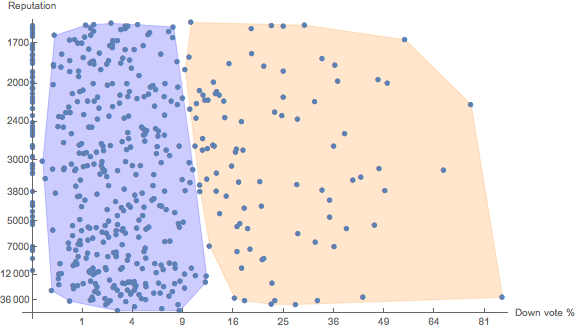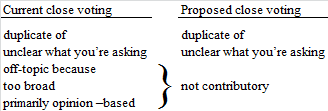This shows three clusters. Note that reciprocal scaling was used on the $y$-axis to produce a dependent variable distribution that was indistinguishable from a uniform distribution. Also, square root transformation of the $x$-axis data removed much of the heavy right-tailed appearance. Visual inspection was used to identify the zero percentage downvoter population as cluster analysis proved problematic for that purpose. Subsequently, k-means did a good job of isolating two populations that were relatively independent of reputation level. From this, and although there seems to be a tendency for increased downvoting with increased reputation, one can still achieve good separation between downvoting populations from the cluster analysis. As a two dimensional histogram this looks like the following

All 500 high repuation users upvoted. There are three statistically
distinct voter populations for percentage downvoting:
13.6% never downvoted; 0% downvote percentage of total votes.
68.0% downvoted at a median percentage of their total votes of
2.79%, 95% of whom downvoted between 0.20% to 9.23% of the time, and
18.4% who downvoted at a median percentage of their total votes of
19.0%; between 9.87% to 67.1%, 95% of the time.
The best cut point between populations 2. and 3. was approximately at 9.79%;
the 96.1 percentile population overlap point between populations.
It would seem that downvoting follows at least three very different behaviours. Consequently, from the viewpoint of the recipient of these downvotes, a downvote is rather easier to attribute to a random event than a rational one, i.e., it may seem to depend more on who is voting than the content of the post being voted upon.
For this author, this suggests that if downvoting behaviour were more systematized, it would be more transparent for the user.
Addendum on 2018-12-05 Given the copious feedback, I am collating the results, if slowlydid further processing. @NickCox suggested using folded square root of percentage downvotes, $\sqrt{x}-\sqrt{100-x}$, on the $x$-axis. This worked well in SPSS in version 13, (old but good), using two-step cluster analysis followed by k-means for a variable number of clusters with the best clustering chosen by BIC. This show the following plot. Two-step cluster analysis showed that classification by reciprocal reputation failed $t$-testing. The cluster data forwarded to k-means then yielded two clusters as below.
The selections off topic, too broad and primarily opinion based are currently being used as alternatives for not-contributory to the site. Those alternatives, even taken together, do not span not-contributory such that current practice is not really addressing the need to prune the site for content that is just not up to par value for expert playopinion.



